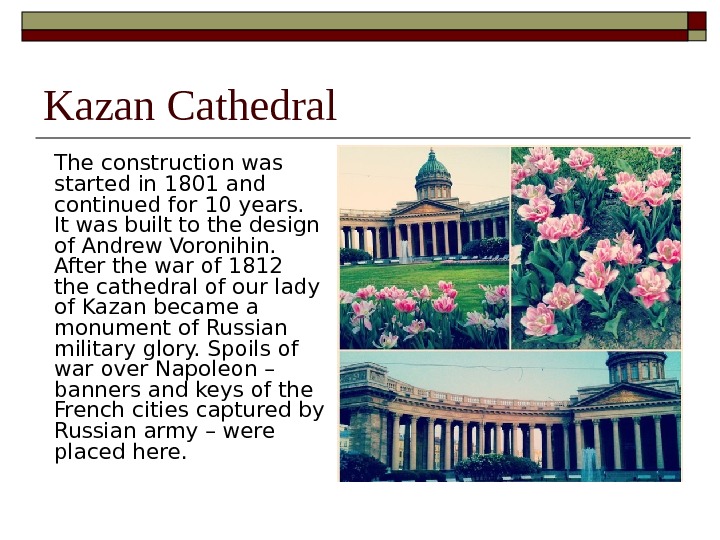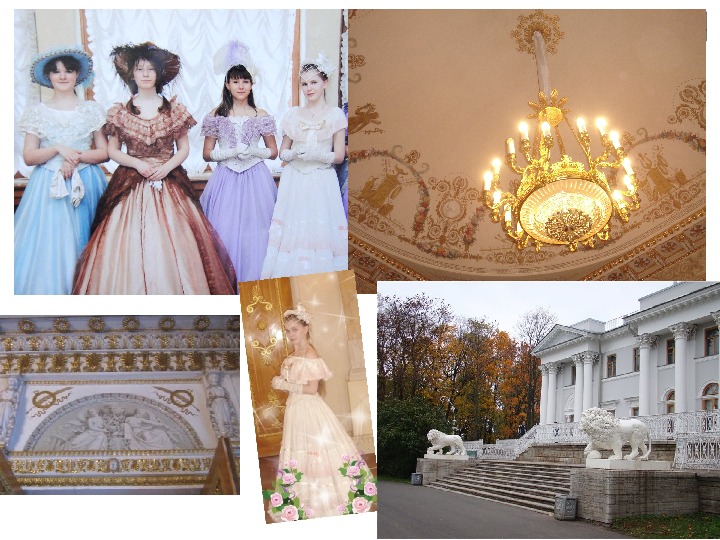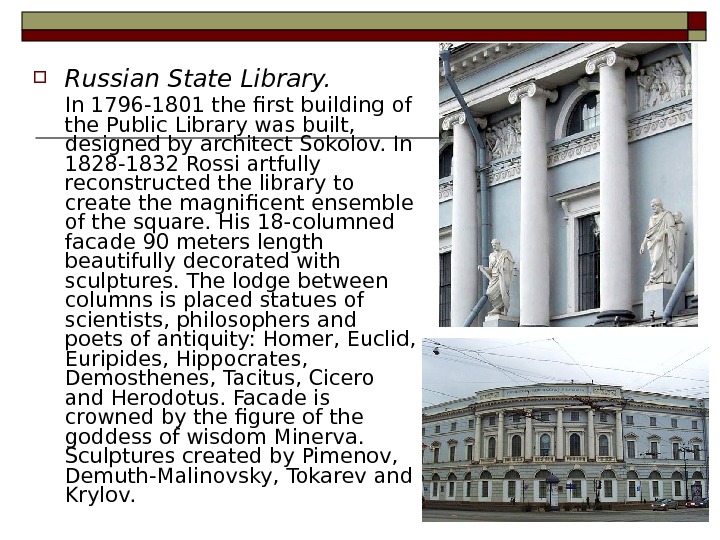Empire style in Saint-Petersburg Efremova Mary 11 “B”















empire_style_in_saint-petersburg.ppt
- Размер: 7.2 Mегабайта
- Количество слайдов: 15
Описание презентации Empire style in Saint-Petersburg Efremova Mary 11 “B” по слайдам
 Empire style in Saint-Petersburg Efremova Mary 11 “B”
Empire style in Saint-Petersburg Efremova Mary 11 “B”
 Kazan Cathedral The construction was started in 1801 and continued for 10 years. It was built to the design of Andrew Voronihin. After the war of 1812 the cathedral of our lady of Kazan became a monument of Russian military glory. Spoils of war over Napoleon – banners and keys of the French cities captured by Russian army – were placed here.
Kazan Cathedral The construction was started in 1801 and continued for 10 years. It was built to the design of Andrew Voronihin. After the war of 1812 the cathedral of our lady of Kazan became a monument of Russian military glory. Spoils of war over Napoleon – banners and keys of the French cities captured by Russian army – were placed here.
 In 1813 Russian commander-in-chief Mikhail Kutuzov was buried here and in front of the building we can see the tomb of this the most famous Russian field-marshal. There is the monument of Barklay de Tolly too. In 1876, the. Kazan demonstration, the first political demonstration in Russia, took place in front of the church. Well-known revolutionist Plehanov said an expressive speech to the gathered people. After this meeting 31 demonstrators was deported to Siberia.
In 1813 Russian commander-in-chief Mikhail Kutuzov was buried here and in front of the building we can see the tomb of this the most famous Russian field-marshal. There is the monument of Barklay de Tolly too. In 1876, the. Kazan demonstration, the first political demonstration in Russia, took place in front of the church. Well-known revolutionist Plehanov said an expressive speech to the gathered people. After this meeting 31 demonstrators was deported to Siberia.
 In 1932 Museum of the History of Religion and Atheism was opened here. In 1992 the cathedral was returned to the Russian Orthodox Church.
In 1932 Museum of the History of Religion and Atheism was opened here. In 1992 the cathedral was returned to the Russian Orthodox Church.
 Stock Exchange is located on t he Spit of Basil Island. It is a huge grey building with white columns. The stock exchange was constructed by French architect. Thomas de Thomon between 1805 and 1810. Today t his building houses the Central Naval Museum. The collection has over 8000 items including a ship of Peter the Great in which he learned to sail when he was a teenager. The collection includes several ancient ships, model ships, submarines, uniforms and photographs , document s the Russian Navy from the time of the. Russian Empire, the. USSR and Russian Federation.
Stock Exchange is located on t he Spit of Basil Island. It is a huge grey building with white columns. The stock exchange was constructed by French architect. Thomas de Thomon between 1805 and 1810. Today t his building houses the Central Naval Museum. The collection has over 8000 items including a ship of Peter the Great in which he learned to sail when he was a teenager. The collection includes several ancient ships, model ships, submarines, uniforms and photographs , document s the Russian Navy from the time of the. Russian Empire, the. USSR and Russian Federation.
 Mikhail’s Palace. The Russian museum The idea of building a new residence for the duke Mikhail Pavlovich owned by his father , Enperor Paul the First. The architect of the Mikhail’s Palace was Karl Rossi. The work started in 1817. Rossi began to create a project of the city’s new architectural ensemble. The square in front of the palace and two new streets ( Engineering and St. Mikhail ) were designed. The State Russian museum ( formally the Russian Museum of His Imperial Majesty Alexander III ) i s the largest museum of Russian art in the world. The museum was established on the 13 th of April in 1895 by Nicholas II.
Mikhail’s Palace. The Russian museum The idea of building a new residence for the duke Mikhail Pavlovich owned by his father , Enperor Paul the First. The architect of the Mikhail’s Palace was Karl Rossi. The work started in 1817. Rossi began to create a project of the city’s new architectural ensemble. The square in front of the palace and two new streets ( Engineering and St. Mikhail ) were designed. The State Russian museum ( formally the Russian Museum of His Imperial Majesty Alexander III ) i s the largest museum of Russian art in the world. The museum was established on the 13 th of April in 1895 by Nicholas II.
 Yelaginsky Palace was constructed in 1822 and it is situated on the Yelagin Island. It used as a royal summer residence during the reign of Alexander I. The architect of the palace is Karl Rossi. The palace was destroyed during the Second World War, but it was restored and nowadays it houses a museum of Russian decorative and applied art and interior of 18 th -20 th centuries.
Yelaginsky Palace was constructed in 1822 and it is situated on the Yelagin Island. It used as a royal summer residence during the reign of Alexander I. The architect of the palace is Karl Rossi. The palace was destroyed during the Second World War, but it was restored and nowadays it houses a museum of Russian decorative and applied art and interior of 18 th -20 th centuries.

 Ostrovsky Square Alexander theatre. This drama theatre is considered to be the work of Rossi. It was built in 1828 -1832 between the Russian State Library and Anichkov Palace. The theatre and the square were named after emperor wife Alexandra Feodorovna. The building is protected by UNESCO.
Ostrovsky Square Alexander theatre. This drama theatre is considered to be the work of Rossi. It was built in 1828 -1832 between the Russian State Library and Anichkov Palace. The theatre and the square were named after emperor wife Alexandra Feodorovna. The building is protected by UNESCO.
 Russian State Library. In 1796 -1801 the first building of the Public Library was built, designed by architect Sokolov. In 1828 -1832 Rossi artfully reconstructed the library to create the magnificent ensemble of the square. His 18 -columned facade 90 meters length beautifully decorated with sculptures. The lodge between columns is placed statues of scientists, philosophers and poets of antiquity: Homer, Euclid, Euripides, Hippocrates, Demosthenes, Tacitus, Cicero and Herodotus. Facade is crowned by the figure of the goddess of wisdom Minerva. Sculptures created by Pimenov, Demuth-Malinovsky, Tokarev and Krylov.
Russian State Library. In 1796 -1801 the first building of the Public Library was built, designed by architect Sokolov. In 1828 -1832 Rossi artfully reconstructed the library to create the magnificent ensemble of the square. His 18 -columned facade 90 meters length beautifully decorated with sculptures. The lodge between columns is placed statues of scientists, philosophers and poets of antiquity: Homer, Euclid, Euripides, Hippocrates, Demosthenes, Tacitus, Cicero and Herodotus. Facade is crowned by the figure of the goddess of wisdom Minerva. Sculptures created by Pimenov, Demuth-Malinovsky, Tokarev and Krylov.
 Street of Rossi The street behind the Ostrovsky square is named after Rossi who contributed greatly to the beauty of our city. Street is famous for its classical proportional. It has 220 meters long and 22 meters wide. The severity of architectural forms street facades show us beauty and elegancy of Alexander theatre.
Street of Rossi The street behind the Ostrovsky square is named after Rossi who contributed greatly to the beauty of our city. Street is famous for its classical proportional. It has 220 meters long and 22 meters wide. The severity of architectural forms street facades show us beauty and elegancy of Alexander theatre.
 The Senate Square In 1829 the Senate building and also in 1830 the building of the Synod were laid. Construction ended in 1834. It was a project of Rossi. Facades and the central arch decorated with columns. The building of the senate has rounded corner which is faced to the Neva river. The sculpture group “Justice and piety” crowning arch created by famous sculptors of the time Pimenov, Demuth-Malinovsky, Sokolov. The Senate and Synod building has 17 meters high. In the design of a triumphal arch Rossi used one of unrealized projects of arch of the General Staff. The Senate and Synod building severely damaged by bombing during the Second World War. Some paintings were saved. Today this building houses the Russian State Historical Archives.
The Senate Square In 1829 the Senate building and also in 1830 the building of the Synod were laid. Construction ended in 1834. It was a project of Rossi. Facades and the central arch decorated with columns. The building of the senate has rounded corner which is faced to the Neva river. The sculpture group “Justice and piety” crowning arch created by famous sculptors of the time Pimenov, Demuth-Malinovsky, Sokolov. The Senate and Synod building has 17 meters high. In the design of a triumphal arch Rossi used one of unrealized projects of arch of the General Staff. The Senate and Synod building severely damaged by bombing during the Second World War. Some paintings were saved. Today this building houses the Russian State Historical Archives.
 The Palace Square. The General Staff In the beginning of the 19 th century the reconstruction of the Palace Square planned. It was associated with the transfer of important state institutes here, they are General Staff of the Russian Army and the two ministries – Foreign Affairs and Finance. Rossi created the project of these two large buildings connected by a solemn triumphal arch. Eastern part of the building closer to the Moyka river was for the two ministries and west which is nearer to the Nevsky Prospect – to the General Staff. Construction of the building was carried out for 10 years (1819 -1829).
The Palace Square. The General Staff In the beginning of the 19 th century the reconstruction of the Palace Square planned. It was associated with the transfer of important state institutes here, they are General Staff of the Russian Army and the two ministries – Foreign Affairs and Finance. Rossi created the project of these two large buildings connected by a solemn triumphal arch. Eastern part of the building closer to the Moyka river was for the two ministries and west which is nearer to the Nevsky Prospect – to the General Staff. Construction of the building was carried out for 10 years (1819 -1829).
 The arch is considered to be the symbol of the victory of Russia in the war of 1812. At the top of the General Staff we can see the Chariot of Glory with six horses.
The arch is considered to be the symbol of the victory of Russia in the war of 1812. At the top of the General Staff we can see the Chariot of Glory with six horses.
 Thank you for your attention!
Thank you for your attention!
